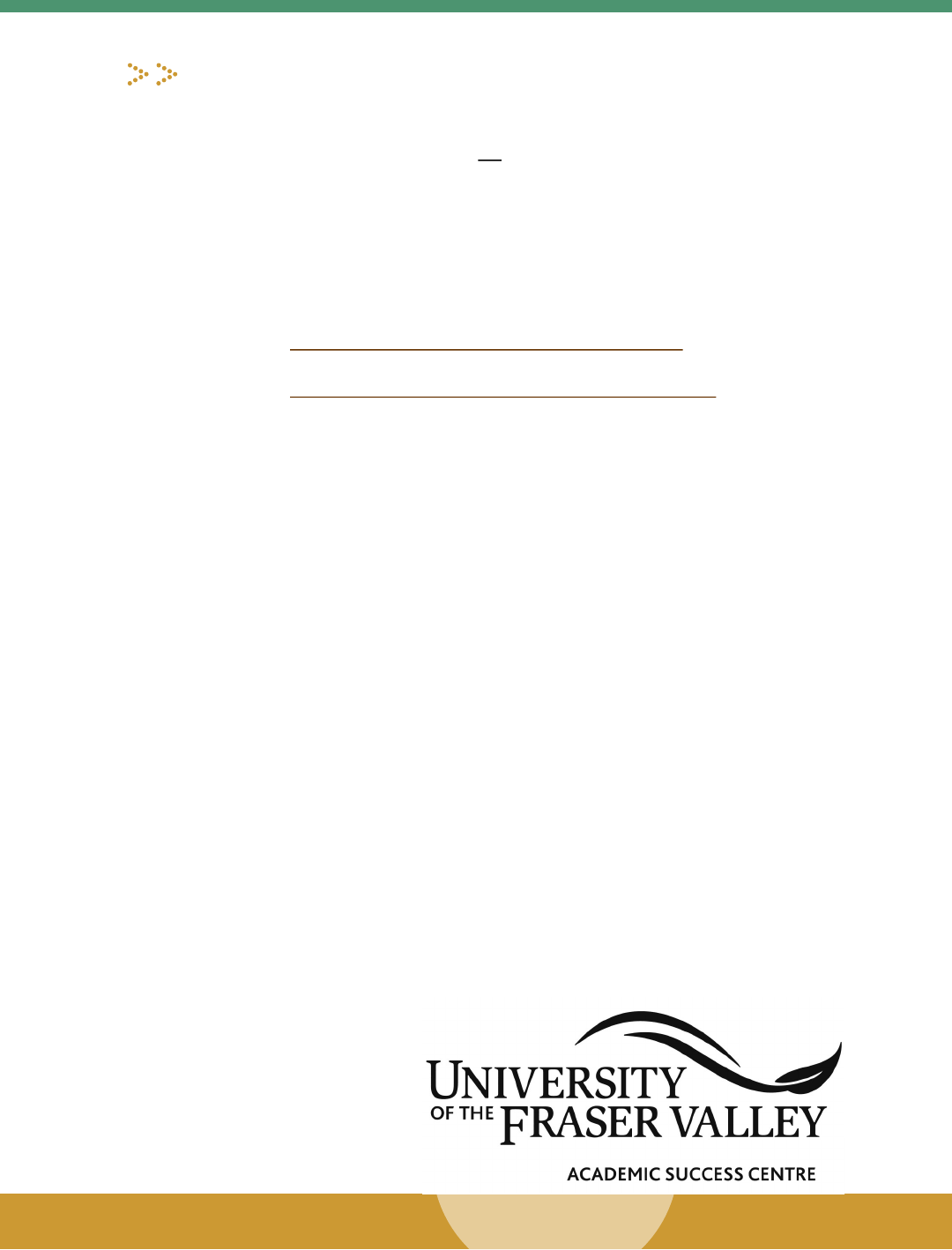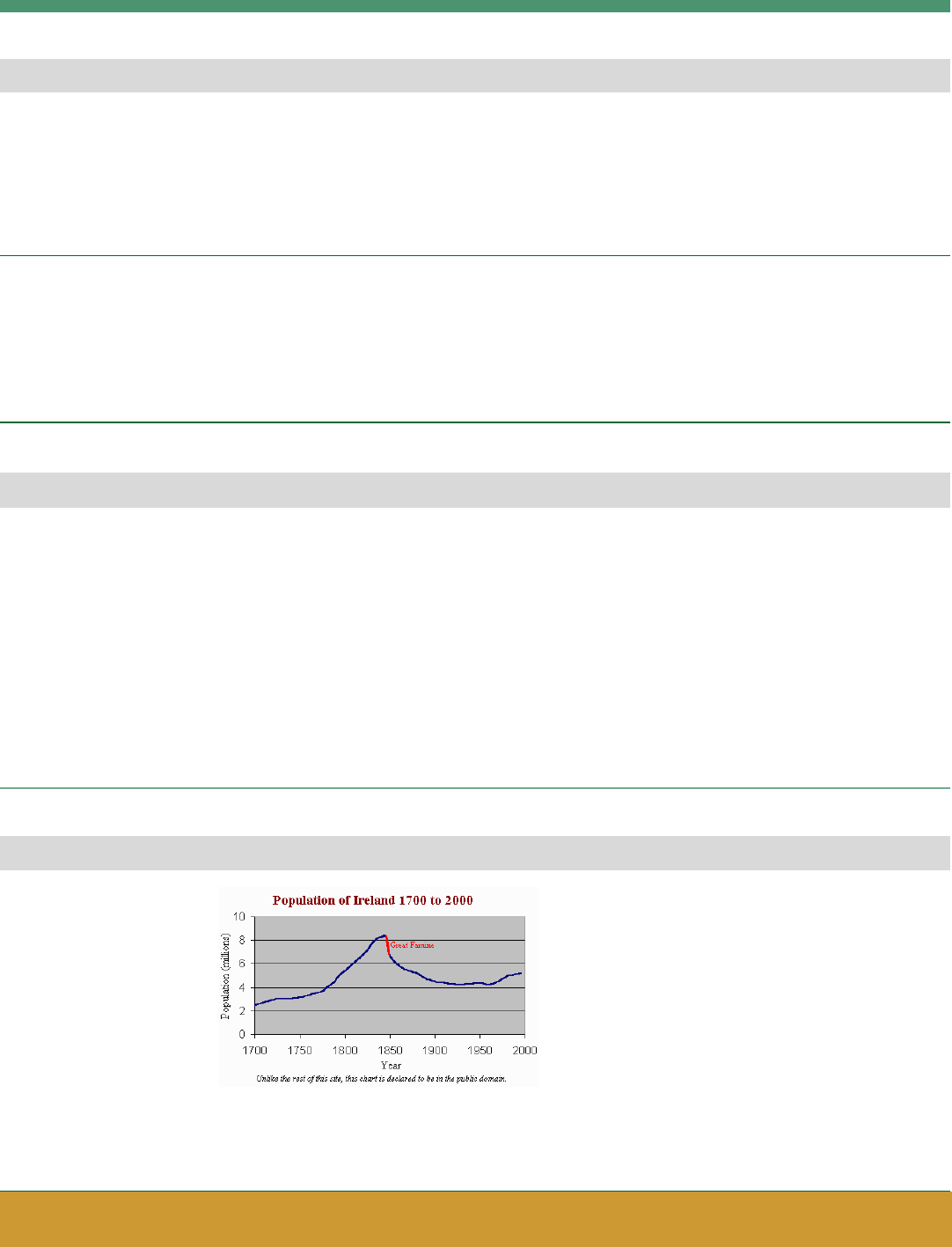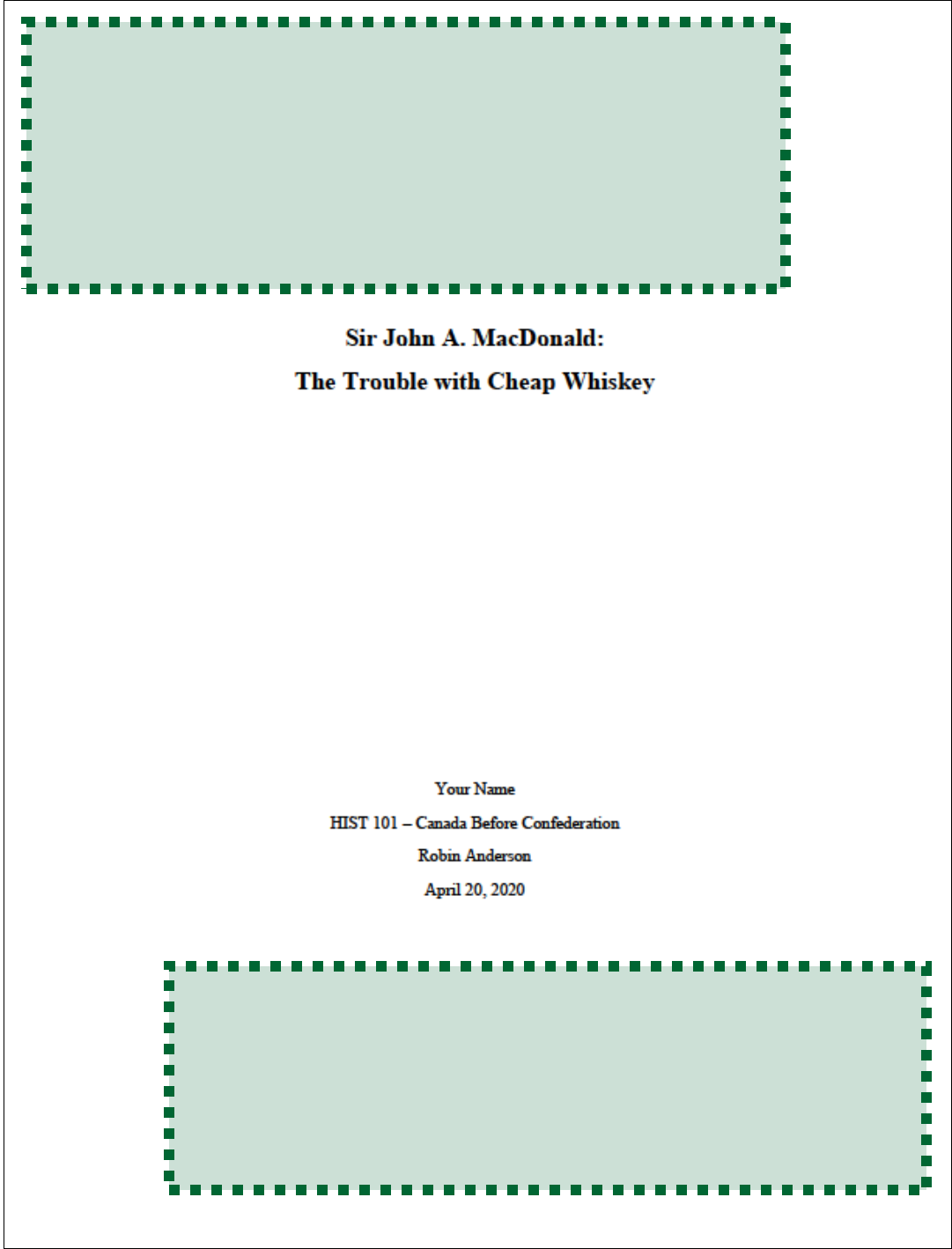
UFV ASC Chicago Documentaon Style, 17th Ed.
June 2019 p. 1
This handout is based on the 17th Edion of The Chicago Manual of Style.
There are two documentaon systems within the larger Chicago Style:
Notes and Bibliography OR Author-Date.
These two systems reect dierent research acvies done by dierent
disciplines. The Academic Success Centre has chosen to address these two
systems separately, so this handout only includes the Notes and
Bibliography style guidelines.
More examples and explanaons can be found online at:
hp://www.chicagomanualofstyle.org/home.html
Or at the Purdue Owl Wring Lab:
hps://owl.english.purdue.edu/owl/resource/717/01/
Chicago Documentation Style
CONTACT: [email protected] www.ufv.ca/asc
(Abbotsford) 604-854-4573; (Chilliwack CEP) 604-504-7441 ext2432
Contents
Denions of Common Terms .............................................................. 2
The Basics of Chicago Style ................................................................... 3
Journals, Newspapers, & Other Periodicals ....................................... 4-5
Books, E-Books, & Book Secons .......................................................... 6
Governments, Universies, Corporaons, & Organizaons ................. 7
Interviews, Ephemera, & Unpublished Essays ...................................... 7
Tables & Figures .................................................................................... 7
Web Documents and Social Media ....................................................... 8
Artworks, Music and Film ...................................................................... 9
Miscellaneous...................................................................................... 10
Sample Notes Page .............................................................................. 10
Sample Bibliography Page ................................................................... 11
Common Formang Concerns
DOI (Digital Object Idener) ............................................................ 2, 4
Two sources with same author(s) and date ...................................... 4, 6
Source-in-Source ................................................................................... 5
Anonymous author ............................................................................... 5
Ibid ........................................................................................................ 6
No date .................................................................................................. 6
Books with three or more authors ........................................................ 6
Chapter in an edited book ..................................................................... 6
Translaon ............................................................................................ 6
Caponing images ................................................................................. 9

UFV ASC Chicago Documentaon Style, 17th Ed.
June 2019 p. 2
In-text citaon: the numerated superscript (raised small font) reference to your source material.
Typically, Chicago Style in-text citaon consists of a superscript number which refers the reader to a footnote
at the boom of the page, or to an endnote in a reference page tled “Notes,” found at the end of the paper
before the Bibliography (see examples throughout this document for variaons).
In-text citaons are generally located at the end of the sentence (including punctuaon) containing the
informaon being cited. Citaons are especially important when using a direct quotaon or paraphrasing a
specic passage.
Bibliography: the list of sources used (referred to) in the document.
The Bibliography (as opposed to References or Works Cited) appears at the end of a document, and is generally
understood to be a comprehensive list of sources gathered when researching a topic, whether or not they have
been referred to in the document being wrien. Bibliographies in Chicago Style are arranged alphabecally by
author’s last name.
A References page is used in APA, not Chicago Style, and contains all of the sources cited in the document that
the reader would be able to access themselves. It does not contain items that have not been referred to in the
document, nor does it contain sources that the reader won’t be able to nd stored somewhere (e.g. personal
conversaons).
A Works Cited page is also similar to a Bibliography, but it is the name used for MLA, not Chicago citaon style.
Periodical: a publicaon that has a recurring date of publicaon (i.e. published over a period of me in a regular
paern). Periodicals include newspapers, magazines, and journals. The recurring date of publicaon could be daily,
weekly, bi-weekly, monthly, quarterly, yearly, etc.
Volume and Issue: numbers used for periodicals to idenfy specically when they were published in terms of
the recurring paern menoned above.
The most common use of volume is to indicate a group of publicaons under one tle that were all published
within the same year. For example, in 2015 all TESOL Quarterly publicaons were idened as “Volume 49.”
TESOL Quarterly began publicaon in 1967, which would be idened as “Volume 1.” Typically, each new year is
given a new sequenal volume number.
Issue is a number that idenes each of the publicaons within one volume. For example, since TESOL Quarterly
is published four mes each year, it has four issues of each volume, idened as issue 1, Issue 2, etc.
DOI: short for Digital Object Idener, this is a “persistent” number that is assigned to a resource (i.e. it will not
change even if the locaon or other bibliographic data about the resource changes). Any kind of resource can be
assigned a DOI; the word “digital” does not describe the locaon of the object (i.e. “online” material only) but does
convey that the idenfying number itself is digital.
University of the Fraser Valley
Academic Success Centre
Denions of Common Terms

UFV ASC Chicago Documentaon Style, 17th Ed.
June 2019 p. 3
The Basics of Chicago Style
Chicago Style includes both Notes and Bibliography.
Each me you make reference to informaon from a source, you have to indicate that source in either a footnote or
endnote. If you are summarizing, paraphrasing, or directly quong, a footnote (endnote, or just note) is necessary to
indicate the full details of the source of the informaon. This diers from other systems of citaon in that there are no
parenthecal references. Idenfy your sources with a superscript number in-text (e.g.
1
), in order of appearance at the
end of the sentence (including punctuaon) containing the informaon you wish to cite.
Think of the in-text numerical citaon as an “Abbotsford 25 km” sign along the highway and the reference page
entry as the sign just outside of town that says “Welcome to Abbotsford, populaon 125,000, Sister City of Fukagawa,
Japan.” The rst sign (in-text citaon) directs you to your desnaon. The second sign (footnote, or endnotes page
entry) tells you that you’ve reached your desnaon and the Bibliography gives you a bigger picture of the place
you’ve arrived at. (In this metaphor, the city of Abbotsford itself would be the original source.) If the rst road sign
said “Abbotsford 25 km” and the second one said “Welcome to Kelowna,” you would be lost. That’s how a reader
might feel if your in-text citaon didn’t lead them directly to your footnote or endnote.
To create a clear path for your reader, notes are in order by number, with name order rst name, last name, as
opposed to the Bibliography, which is organized alphabecally with last name, rst. The Bibliography also contains all
gathered sources, even if they are not directly cited. There are other slight dierences between the two which are
demonstrated here. This duplicaon of informaon is useful to the reader to locate your sources easily.
In-text:
… author Laurel Seon MacDowell describes the evoluon of environmental history in Canada.
1
Note: (Footnote or Endnote)
1
Laurel Seon MacDowell, An Environmental History of Canada (Vancouver: UBC Press, 2012), 2.
Bibliography:
MacDowell, Laurel Seon. An Environmental History of Canada. Vancouver: UBC Press, 2012.
Despite how complicated Chicago citaons look, they are all comprised of basic elements, always in the same order:
WHO (author, editor, producer, “organizaon as author,” tle if no author or organizaon is named)
WHAT (tle of book, arcle, movie, report, etc.)
WHERE (city and publisher) (for online sources, the URL or DOI are added to the end of the reference)
WHEN (date of publicaon: usually just the year, but could also include month, day, or season)
All items cited should follow this basic paern. Dierent formats of publicaon will have dierent ways of expressing
these basic parts, but the paern doesn’t change. It’s helpful to think of each of the basic parts as a unit of meaning,
like a sentence that is followed by a period before the next “idea” begins. Cing from a book is the simplest form:
Note:
1
First name, Last name, Title of publicaon. (City: Publisher, Date), Page.
Bibliography: Last name, First Name. Title of publicaon. City: Publisher. Date.
University of the Fraser Valley
Academic Success Centre

UFV ASC Chicago Documentaon Style, 17th Ed.
June 2019 p. 4
Journals, Newspapers, and Periodicals (Online and Print)
Source Type Notes and Bibliography
Magazine,
online, one
author
Note:
Bib:
1
Eric Hobsbawm, “In Defence of History,” The Guardian January 15, 2005, hps://
www.theguardian.com/books/2005/jan/15/news.comment/.
Hobsbawm, Eric. “In Defence of History.” The Guardian January 15, 2005. hps://www.
theguardian.com/books/2005/jan/15/news.comment/.
Newspaper,
online, one
author
Note:
Bib:
2
Jusne Hunter, “A Mission to Find the History Hidden Along Canada’s West Coast,”
The Globe and Mail November 10, 2017, hps://www.theglobeandmail.com/news/brish-
columbia/mission-to-nd-history-hidden-along-canadas-west-coast/arcle36927503/.
Hunter, Jusne. “A Mission to Find the History Hidden Along Canada’s West Coast.” The
Globe and Mail November 10, 2017. hps://www.theglobeandmail.com/news/brish-
columbia/mission-to-nd-history-hidden-along-canadas-west-coast/arcle36927503/.
Journal, online,
two authors
Note:
Bib:
3
Mary J. Hatch and Majken Schultz, “Toward a Theory of Using History Authencally:
Historicizing in the Carlsberg Group,” Administrave Science Quarterly 62, no. 4 (December
2017): 657-697, doi: 10.1177/0001839217692535.
Hatch, Mary J., and Majken Schultz. “Toward a Theory of Using History Authencally:
Historicizing in the Carlsberg Group.” Administrave Science Quarterly 62, no. 4
(December 2017): 657-697. doi: 10.1177/0001839217692535.
Journal, online,
one author
Note:
Bib:
4
Sasha Mullally, "Marginally Relevant?: The ‘Fathers of Confederaon’ and Canadian
History," The Canadian Historical Review 98, no. 4 (2017): 727-741, hps://muse.jhu.edu/
arcle/679108.
Mullally, Sasha. "Marginally Relevant?: The ‘Fathers of Confederaon’ and Canadian
History." The Canadian Historical Review 98, no. 4 (2017): 727-741. hps://
muse.jhu.edu/arcle/679108.
Journal, online,
four or more
authors
Note:
Bib:
5
Mohammadali M. Shoja et al., “The Roman Empire Legacy of Galen (129-200 AD),”
Child’s Nervous System 31, no. 1 (January 2015): 1-5, doi: 10.1007/s00381-014-2467-7.
Shoja, Mohammadali M., Shane R. Tubbs, Kamyar Ghabili, Christoph J. Griessenauer, Marga-
ret W. Blach, and Mariana Cuceu. “The Roman Empire Legacy of Galen (129-200 AD).”
Child’s Nervous System 31, no. 1 (January 2015): 1-5. doi:10.1007/s00381-014-2467-7.
Journal, online
with DOI
Note:
Bib:
6
Ambrogio A. Caiani, “Ornamentalism in a European Context?: Napoleon’s Italian
Coronaon, 26 May 1805,” English Historical Review 132, no. 554 (February 2017): 71-72, doi:
10.1093/ehr/cex067.
Caiani, Ambrogio A. “Ornamentalism in a European Context?: Napoleon’s Italian Coronaon,
26 May 1805.” English Historical Review 132, no. 554 (February 2017): 41-72. doi:
10.1093/ehr/cex067.
Journal arcle,
print
Note:
Bib:
7
Dimitry Anastakis and Mary-Ellen Kelm, "A Century of the Canadian Historical Review:
Speaking to the Past, Present, and Future of Canadian History and Canada," Scholarly & Re-
search Communicaon 9, no. 1 (January 2018): 1-6.
Anastakis, Dimitry, and Mary-Ellen Kelm. "A Century of the Canadian Historical Review:
Speaking to the Past, Present, and Future of Canadian History and Canada." Scholarly &
Research Communicaon 9, no. 1 (January 2018): 1-6.
University of the Fraser Valley
Academic Success Centre

UFV ASC Chicago Documentaon Style, 17th Ed.
June 2019 p. 5
Journals, Newspapers, and Periodicals (Connued)
Source Type Notes and Bibliography
Journal arcle
with anonymous
author
Note:
Bib:
8
Anonymous, “In Defense of Anonymity,” Virginia Quarterly Review 63 (Winter
1987): 124-132, hp://www.vqronline.org/essay/defense-anonymity/.
Anonymous. “In Defense of Anonymity.” Virginia Quarterly Review 63 (Winter 1987): 124-
132. hp://www.vqronline.org/essay/defense-anonymity/.
*An anonymous author is not the same as “no author.” If no author is idened, then use
the tle or the publisher as the author; if the author is idened as “Anonymous,” then use
that word as you would an author’s family name. Include URL or DOI for online sources.
Journal arcle,
source-in-source
Note:
Bib:
9
J.R. Miller, “The 1891 Elecon in Western Canada,” Prairie Forum January 10,
1985, quoted in Patricia K. Wood, “Dening ‘Canadian’: An-Americanism and Identy in
Sir John A. Macdonald’s Naonalism,” Journal of Canadian Studies 36, no. 2 (Summer
2001): 49-69.
Miller, J.R. “The 1891 Elecon in Western Canada.” Prairie Forum January 10, 1985.
Quoted in Wood, Patricia K. “Dening ‘Canadian’: An-Americanism and Identy in
Sir John A. Macdonald’s Naonalism,” Journal of Canadian Studies 36, no. 2
(Summer 2001): 49-69.
*Use “source-in-source” to show that you are using a source you found in one of your
secondary sources but you have not seen the original. Use this sparingly; make an eort
to nd original sources.
Two Journal
arcles with the
same authors &
same publicaon
date
Note 1:
Note 2:
Bib 1:
Bib 2:
10
Jennifer Brewer, “Revising Maine’s Lobster Commons: Rescaling Polical
Subjects,” Internaonal Journal of the Commons 6, no. 2 (2012): 319-343, doi: 10.18352/
ijc.336.
11
Jennifer Brewer, “Don’t Fence Me In: Boundaries, Policy, and Deliberaon in
Maine’s Lobster Commons,” Annals of the Associaon of American Geographers 102, no.
2 (2012): 383-402, doi: 10.1080/00045608.2011.641889.
Brewer, Jennifer. “Don’t Fence Me In: Boundaries, Policy, and Deliberaon in Maine’s
Lobster Commons.” Annals of the Associaon of American Geographers 102, no. 2
(2012): 383-402. doi: 10.1080/00045608.2011.641889.
———. “Revising Maine’s Lobster Commons: Rescaling Polical Subjects.” Internaonal
Journal of the Commons 6, no. 2 (2012): 319-343. doi: 10.18352/ijc.336.
*List mulple bibliographical references with the same author alphabecally by tle, or by
earliest publicaon date. If there is no other opon, add an “a” and “b” to the dates.
University of the Fraser Valley
Academic Success Centre
Cing one source mulple mes: You only need to include the full reference in your Notes the rst me in mulple consecuve
citaons. For the second (third, fourth, etc.) Note, you only need to include author, a short form of the tle, and the page number.
12
Isaac Asimov, Foundaon (New York: Gnome Press, 1951), 43.
13
Asimov, Foundaon, 44.
Ibid: This Lan abbreviaon is somemes used to refer to work cited in the previous note, instead of the shortened entry.
Regreably, the 17th edion of The Chicago Manual of Style no longer recommends the use of ibid, but you can always check
with your instructor to nd out which abbreviaon they prefer.
No date: If there is no date provided for your source, insert n.d. in its place.

UFV ASC Chicago Documentaon Style, 17th Ed.
June 2019 p. 6
Books, E-Books, and Book Secons
Source Type Notes and Bibliography
Print book with
one author
Note:
Bib:
1
Karl Popper, The Poverty of Historicism (Boston: Beacon Press, 1957), 149.
Popper, Karl. The Poverty of Historicism. Boston: Beacon Press, 1957.
E-Book with one
author
Note:
Bib:
2
John Arnold, History: A Very Short Introducon (Oxford: Oxford University Press,
2000), 7, hp://www.myilibrary.com?ID=37494.
Arnold, John. History: A Very Short Introducon. Oxford: Oxford University Press, 2000.
hp://www.myilibrary.com?ID=37494.
Book with two
authors, print
Note:
Bib:
3
Anna Green and Kathleen Troup, The Houses of History: A Crical Reader in
History and Theory, 2nd ed. (Manchester: Manchester University Press, 2016), 291.
Green, Anna, and Kathleen Troup. The Houses of History: A Crical reader in history and
Theory, 2nd ed. Manchester: Manchester University Press, 2016.
Book with four or
more authors,
print
Note:
Bib:
4
Ernst Curus, et al., The History of Greece (New York: C. Scribner and Company,
1899), 55.
Curus, Ernst, William A. Packard, and Sir Adolphus William Ward. The History of Greece.
New York: C. Scribner and Company, 1899.
Chapter or secon
in edited book,
mul-volume,
print
Note:
Bib:
5
Murray Rothbard, “Alienaon, Unity, and the Dialecc,” in Classical Economics
Vol. II, ed. Mark Blaug (Auburn: Edward Elgar Publishing, 1995), 365.
Rothbard, Murray. “Alienaon, Unity, and the Dialecc.” In Classical Economics Vol. II,
edit. Mark Blaug, 364-366. Auburn: Edward Elgar Publishing, 1995.
Two books with
the same author
Note 1:
Note 2:
Bib 1:
Bib 2:
6
Peter Ackroyd, Dan Leno and the Limehouse Golem (London: Vintage Books,
1997), 123.
7
Peter Ackroyd, Blake, (London: Vintage Books, 1997), 456.
Ackroyd, Peter. Blake. London: Vintage Books, 1997.
———. Dan Leno and the Limehouse Golem. London: Vintage Books, 1997.
*List mulple Bibliographical references with the same author alphabecally by tle, or
earliest publicaon date. Replace the name with a long dash, or three “em-dashes”.
Translated book Note:
Bib:
8
Immanuel Kant, Crique of Pure Reason, trans. Paul Guyer and Allen W. Wood
(Cambridge: Cambridge University Press, 1998), 36.
Kant, Immanuel. Crique of Pure Reason. Translated by Paul Guyer and Allen W. Wood.
Cambridge: Cambridge University Press, 1998.
Primary source Note:
Bib:
9
Elizabeth Tudor, “Leer to Mary Queen of Scots 1586,” from The Elizabeth Files,
last modied 2014, hp://www.elizabethles.com/resources/leers-of-elizabeth-i/leer-
to-mary-queen-of-scots-1586/.
Tudor, Elizabeth. “Leer to Mary Queen of Scots 1586,” from The Elizabeth Files, last
modied 2014. hp://www.elizabethles.com/resources/leers-of-elizabeth-i/
leer-to-mary-queen-of-scots-1586/.
University of the Fraser Valley
Academic Success Centre

UFV ASC Chicago Documentaon Style, 17th Ed.
June 2019 p. 7
Governments, Universies, Corporaons, & Organizaons
Source Type Notes and Bibliography
Government
website, pdf
document
Note:
Bib:
1
Stascs Canada, Esmated populaon of Canada, 1867 to 1977 (Oawa: Stascs
Canada), accessed March 7, 2018, hps://www.statcan.gc.ca/pub/11-516-x/
secona/4147436-eng.htm.
Stascs Canada. Esmated populaon of Canada, 1867 to 1977. Oawa: Stascs Canada.
Accessed March 7, 2018. hps://www.statcan.gc.ca/pub/11-516-x/secona/4147436-
eng.htm.
Organizaon,
online report
Note:
Bib:
2
Greenpeace Internaonal, Fernando Pereira 1950 – 1985 (Amsterdam: Greenpeace
Internaonal), hps://www.greenpeace.org/archive-internaonal/en/about/history/the-
bombing-of-the-rainbow-war/Fernando-Pereira/.
Greenpeace Internaonal. Fernando Pereira 1950 – 1985. Amsterdam: Greenpeace
Internaonal. hps://www.greenpeace.org/archive-internaonal/en/about/history/
the-bombing-of-the-rainbow-war/Fernando-Pereira/.
Interviews, Unpublished Essays & Ephemera
Source Type Notes and Bibliography
Unpublished
essay, or your
own work,
Miscellaneous
Note:
Bib:
3
Jones, M., A History of Abbotsford, Unpublished essay, Department of History
(Abbotsford: University of the Fraser Valley, 2018).
Jones, M. A History of Abbotsford. Unpublished essay, Department of History. Abbotsford:
University of the Fraser Valley, 2018.
*Reusing content produced originally for a dierent purpose (e.g. copying sentences or para-
graphs from an essay you wrote in one class to help you complete an essay in a second class)
is considered plagiarism. To avoid this, cite your own work as you would any other source.
*Class notes and other sources that the reader cannot retrieve themselves do not need to be
included on the Bibliography page. Examples: email, personal interviews, conversaons,
leers, class Course handouts not available publically, etc.
Tables & Figures
Source Type Capon and Bibliography
Table, Figure,
Chart, Diagram,
or Map
Capon:
Bib:
(Fig. 1) Populaon of Ireland 1700 to 2000 (Wesley Johnston, Public Domain).
Johnston, Wesley. Prelude to Famine 4: Demographics. Last Updated 2001. hp://
www.wesleyjohnston.com/users/ireland/past/famine/demographics_pre.html.
University of the Fraser Valley
Academic Success Centre

UFV ASC Chicago Documentaon Style, 17th Ed.
June 2019 p. 8
Social Media and Web
Source Type Notes and Bibliography
Blog post,
webpage
Note:
Bib:
1
Susan Holloway Sco, “How Many Hours to Stch a Woman’s Gown in 1775?” Two
Nerdy History Girls (Blog) March 4, 2018, hp://twonerdyhistorygirls.blogspot.ca/2018/03/
how-many-hours-to-stch-womans-gown-in.html.
Holloway Sco, Susan. “How Many Hours to Stch a Woman’s Gown in 1775?” Two Nerdy
History Girls (Blog). March 4, 2018. hp://twonerdyhistorygirls.blogspot.ca/2018/03/
how-many-hours-to-stch-womans-gown-in.html.
YouTube video Note:
Bib:
2
goUFV, Meet Jack — Academic Integrity (video le) (Abbotsford: University of the
Fraser Valley, 2016), hps://www.youtube.com/watch?v=59d1bJjKul0&feature=youtu.be.
goUFV. Meet Jack — Academic Integrity (video le). Abbotsford: University of the Fraser
Valley, 2016. hps://www.youtube.com/watch?v=59d1bJjKul0&feature=youtu.be.
Facebook or
Twier update,
group or
organizaon as
author
Note:
Bib:
3
Chilliwack Museum and Archives. Thank you to all our hardworking volunteers!
(Facebook post) December 15, 2017, hps://www.facebook.com/ChilliwackMuseum
Archives/?hc_ref=ARR0HGxca3feRNhpyZDVRDVGrIWd0LOT4rM8yZLC2tVdJVkLBE4Nmwlco
HVRBlmext4&fref=nf.
Chilliwack Museum and Archives. Thank you to all our hardworking volunteers! (Facebook
post) December 15, 2017. hps://www.facebook.com/ChilliwackMuseumArchives/?
hc_ref= ARR0HGxca3feRNhpyZDVRDVGrIWd0LOT4rM8yZLC2tVdJVkLBE4Nmwlco-
HVRBlmext4&fref=nf.
Podcast Note:
Bib:
4
Russell Brand and Tony Howard, “Shakespeare and Power!” Under The Skin (Podcast)
December 23, 2017, hps://www.russellbrand.com/podcasts/page/2/.
Brand, Russell, and Tony Howard. “Shakespeare and Power!” Under The Skin (Podcast)
December 23, 2017. hps://www.russellbrand.com/podcasts/page/2/.
News report,
online video, no
author, long tle
Note:
Bib:
5
Global News, Halifax Council to Decide Whether They’ll Remove Controversial
Cornwallis Statue (television news segment) January 29, 2018. (Halifax: Corus Entertainment
Inc.), hps://globalnews.ca/news/3993989/cornwallis-halifax-council/.
Global News. Halifax Council to Decide Whether They’ll Remove Controversial Cornwallis
Statue (television news segment) January 29, 2018. Halifax: Corus Entertainment Inc.
hps://globalnews.ca/news/3993989/cornwallis-halifax-council/.
University of the Fraser Valley
Academic Success Centre
Remember that your instructor may not consider social media or web references to be scholarly sources.
Noce that the order of the date elements. Use Month Day Year, not Year Month Day.
The “author” for social media source citaons is the person who posted the content, not the person who created
it. Individuals associated with the creaon of the informaon should be menoned at an appropriate place in
the text of your wring.
If there is no publicaon date available, include the date you accessed the site: e.g. Accessed September 5, 2019.
Insert before the URL or DOI.
There is no need to cite the source of a hashtag even if it is a search term used in conducng research.
Long source tles can be shortened when used in place of author in in-text citaons. Keep enough of the
original tle for clarity.
Don’t forget to disable all hyperlinks from URL scripts.

UFV ASC Chicago Documentaon Style, 17th Ed.
June 2019 p. 9
University of the Fraser Valley
Academic Success Centre
Points for Sample Notes and Bibliography Pages (Pp. 10 and 11)
Start your Endnotes and Bibliography on new pages of your document; place them at the end of the text of the document,
Notes rst (if using endnote format instead of footnotes in the body of your paper), and then Bibliography.
Choose a clear, easy-to-read typeface for your enre document; Times New Roman is recommended.
Type the one-word tle (e.g. Notes), centred with no other formang (do not underline, bold, or italicize). Do not use a
larger font size for the tle; it must be the same font and size as the rest of the text.
The standard line-spacing rule in all Chicago formaed documents is single, double-spaced between entries. The line spacing
shown on the sample Endnotes and Bibliography Pages is what you should use in your document.
All Notes are listed in numerical order, note the dierences in formang from the Bibliography, such as name order and
parentheses. Also, Notes are indented on the rst line of each entry, the Bibliography uses a “hanging” indent.
Alphabeze the Bibliography. List using the author’s last name or whatever word appears rst (i.e. organizaon or tle if
author is unknown).
Be very careful with capitalizaon, italics, and punctuaon. These all communicate meaning to the reader. For example, italic
leers generally tell the reader that the source is a stand-alone publicaon, not a shorter work inside a larger one.
Artwork, Music and Film
Source Type Capons and Bibliography
Artwork,
Photo,
Sculpture,
Installaon,
etc.
Capon:
Fig. 1. Joseph Mallard William Turner, Calais Pier, 1803. Oil on canvas. 172 x 240 cm (67.5 x
94.5 in). The Naonal Gallery, London.
Organize capons in this order, minding punctuaon:
Arst, Artwork, date. Medium, dimensions. Current locaon.
*Capons are usually placed underneath the image, but can be replaced with gure label (e.g.
Fig. 1, Fig. 2) with capon moved to a separate Artworks or Images page, in numerical order.
2- or 3-dimensional measurements of artwork are metric in Canada and Europe, but you may
wish to include imperial conversions as well. Some instructors may require references to the
online locaon or URL of your images, but no bibliographical entry is needed. However, any
wrien informaon cited about the image does need to be referenced.
Music
Recording
Note:
Bib:
2
Wolfgang Amadeus Mozart, “Serenade in D, K320, ‘Posthorn,’” in The Great Serenades
Including Eine Kleine Nachtmusik, performed by Neville Marriner and the Academy of St.
Marn in the Fields (Amsterdam: Philips Duo 4640222, 1999), CD.
Mozart, Wolfgang Amadeus. “Serenade in D, K320, ‘Posthorn’” in The Great Serenades
Including Eine Kleine Nachtmusik. Performed by Neville Marriner and the Academy of St.
Marn in the Fields. Amsterdam: Philips Duo 4640222, 1999. CD.
Film Note:
Bib:
3
Jane Austen and Seth Graeme-Smith, Pride and Prejudice and Zombies, directed by
Burr Steers (Santa Monica: Lionsgate, 2016), DVD.
Austen, Jane, and Seth Graeme-Smith. Pride and Prejudice and Zombies. Directed by Burr
Steers. Santa Monica: Lionsgate, 2016. DVD.
Note: Before reproducing any image (e.g. artworks, photographs, or tables), ensure that you do not need to secure
permission from the copyright holder. Typically, but not always, this kind of reproducon falls under Fair Use or Fair
Dealing regulaons for educaonal or academic purposes, so permission does not need to be sought. If your image has
a Creave Commons license that permits use, then you do not need to seek permission. Clip art that is part of a
purchased product, such as Microso soware, is free for the license holder to use and it does not need to be cited
in-text or in your Bibliography.

UFV ASC Chicago Documentaon Style, 17th Ed.
June 2019 p. 10
Begin page numbers at the beginning of the essay, you do not need
to number the tle page
Use the same font as you have used in your paper, usually Times
New Roman
The tle goes about a third of the way down
You can slightly enlarge and bold the tle
Centre all text
Include your name, student number, course, date, and any other
informaon your instructor requests.
Art history papers allow for more creave freedom with tle pages.
The space can be useful prinng real estate for required images!

UFV ASC Chicago Documentaon Style, 17th Ed.
June 2019 p. 11
University of the Fraser Valley
Notes
1. Eric Hobsbawm, “In Defence of History,” The Guardian January 15, 2005, https://
www.theguardian.com/books/2005/jan/15/news.comment/.
2. Justine Hunter, “A Mission to Find the History Hidden Along Canada’s West Coast,”
The Globe and Mail November 10, 2017, https://www.theglobeandmail.com/news/british-columbia/
mission-to-find-history-hidden-along-canadas-west-coast/article36927503/.
3. Mary J. Hatch and Majken Schultz, “Toward a Theory of Using History Authentically:
Historicizing in the Carlsberg Group,” Administrative Science Quarterly 62, no. 4 (December 2017):
657-697, doi: 10.1177/0001839217692535.
4. Sasha Mullally, "Marginally Relevant?: The ‘Fathers of Confederation’ and Canadian
History," The Canadian Historical Review 98, no. 4 (2017): 727-741, https://muse.jhu.edu/article/
679108.
5. Mohammadali M. Shoja et al., “The Roman Empire Legacy of Galen (129-200 AD),”
Child’s Nervous System 31, no. 1 (January 2015): 1-5, doi: 10.1007/s00381-014-2467-7.
6. Ambrogio A. Caiani, “Ornamentalism in a European Context? Napoleon’s Italian Corona-
tion, 26 May, 1805,” English Historical Review 132, no. 554 (February 2017): 71-72, doi:10.1093/
ehr/cex067.
7. Dimitry Anastakis and Mary-Ellen Kelm, "A Century of the Canadian Historical Review:
Speaking to the Past, Present, and Future of Canadian History and Canada," Scholarly & Research
Communication 9, no. 1 (January 2018): 1-6.
8. Anonymous, “In Defense of Anonymity,” Virginia Quarterly Review 63 (Winter 1987):
124-132, http://www.vqronline.org/essay/defense-anonymity/.
9. J.R. Miller, “The 1891 Election in Western Canada,” Prairie Forum January 10, 1985,
quoted in Patricia K. Wood, “Defining ‘Canadian’: Anti-Americanism and Identity in Sir John A.
Macdonald’s Nationalism,” Journal of Canadian Studies 36, no. 2 (Summer 2001): 49-69.
10. Jennifer Brewer, “Revisiting Maine’s Lobster Commons: Rescaling Political Subjects,”
International Journal of the Commons 6, no. 2 (2012): 319-343, doi: 10.18352/ijc.336.
11. Brewer, “Lobster Commons,” 319.
12. Jennifer Brewer, “Don’t Fence Me In: Boundaries, Policy, and Deliberation in Maine’s
Lobster Commons,” Annals of the Association of A merican Geographers 102, no. 2 (2012): 383-
402, doi: 10.1080/00045608.2011.641889.

UFV ASC Chicago Documentaon Style, 17th Ed.
June 2019 p. 12
University of the Fraser Valley
Academic Success Centre
Bibliography
Ackroyd, Peter. Blake. London: Vintage Books, 1997.
———. Dan Leno and the Limehouse Golem. London: Vintage Books, 1997.
Anastakis, Dimitry, and Mary-Ellen Kelm. "A Century of the Canadian Historical Review: Speaking
to the Past, Present, and Future of Canadian History and Canada." Scholarly & Research
Communication 9, no. 1 (January 2018): 1-6.
Anonymous. “In Defense of Anonymity.” V irginia Quarterly Review 63 (Winter 1987): 124-132.
http://www.vqronline.org/essay/defense-anonymity/.
Arnold, John. History: A Very Short Introduction. Oxford: Oxford University Press, 2000. http://
www.myilibrary.com?ID=37494.
Austen, Jane, and Seth Graeme-Smith. Pride and Prejudice and Zombies. Directed by Burr Steers.
Santa Monica: Lionsgate, 2016. DVD.
Brand, Russell, and Tony Howard. “Shakespeare and power!” Under The Skin (Podcast) December
23 2017. https://www.russellbrand.com/podcasts/page/2/.
Brewer, Jennifer. “Don’t Fence Me In: Boundaries, Policy, and Deliberation in Maine’s Lobster
Commons.” Annals of the Association of American Geographers 102, no. 2 (2012): 383-402.
doi: 10.1080/00045608.2011.641889.
———. “Revisiting Maine’s Lobster Commons: Rescaling Political Subjects.” International Jour-
nal of the Commons 6, no. 2 (2012): 319-343. doi:10.18352/ijc.336.
Caiani, Ambrogio A. “Ornamentalism in a European Context? Napoleon’s Italian Coronation, 26
May 1805.” English Historical Review 132, no. 554 (February 2017): 41-72. doi:10.1093/ehr/
cex067.
Chilliwack Museum and Archives. Thank you to all our hardworking volunteers! (Facebook post)
December 15, 2017. https://www.facebook.com/ChilliwackMuseumArchives/?hc_ref=ARR0
HGxca3feRNhpyZDVRDVGrIWd0LOT4rM8yZLC2tVdJVkLBE4NmwlcoHVRBlmext4&
fref=nf.
Curtius, Ernst, William A. Packard, and Adolphus William Ward. The History of Greece. New
York: C. Scribner and Company, 1899.
